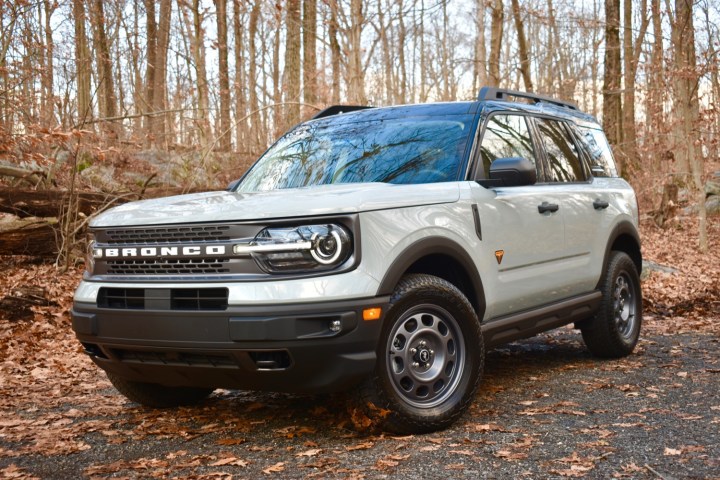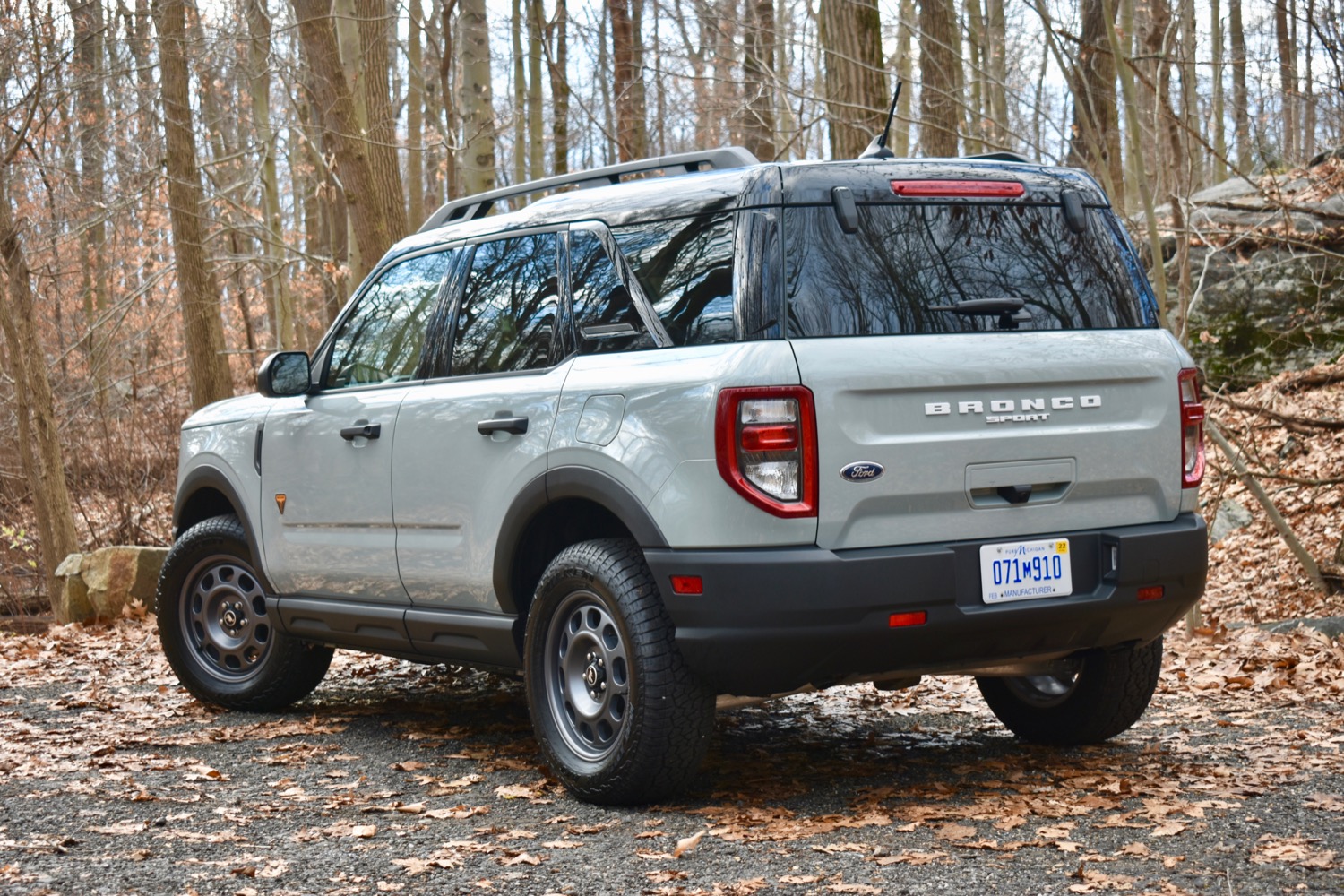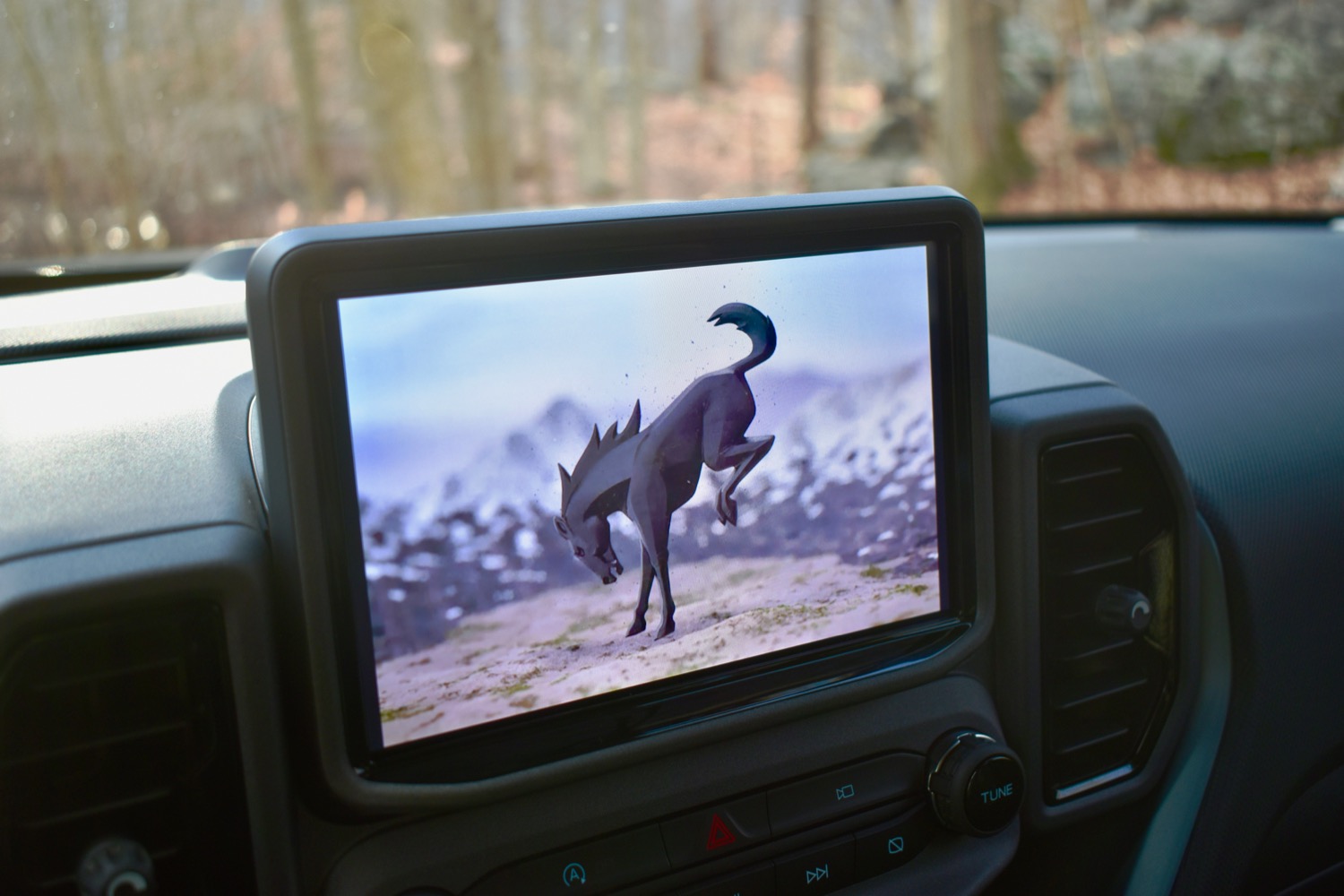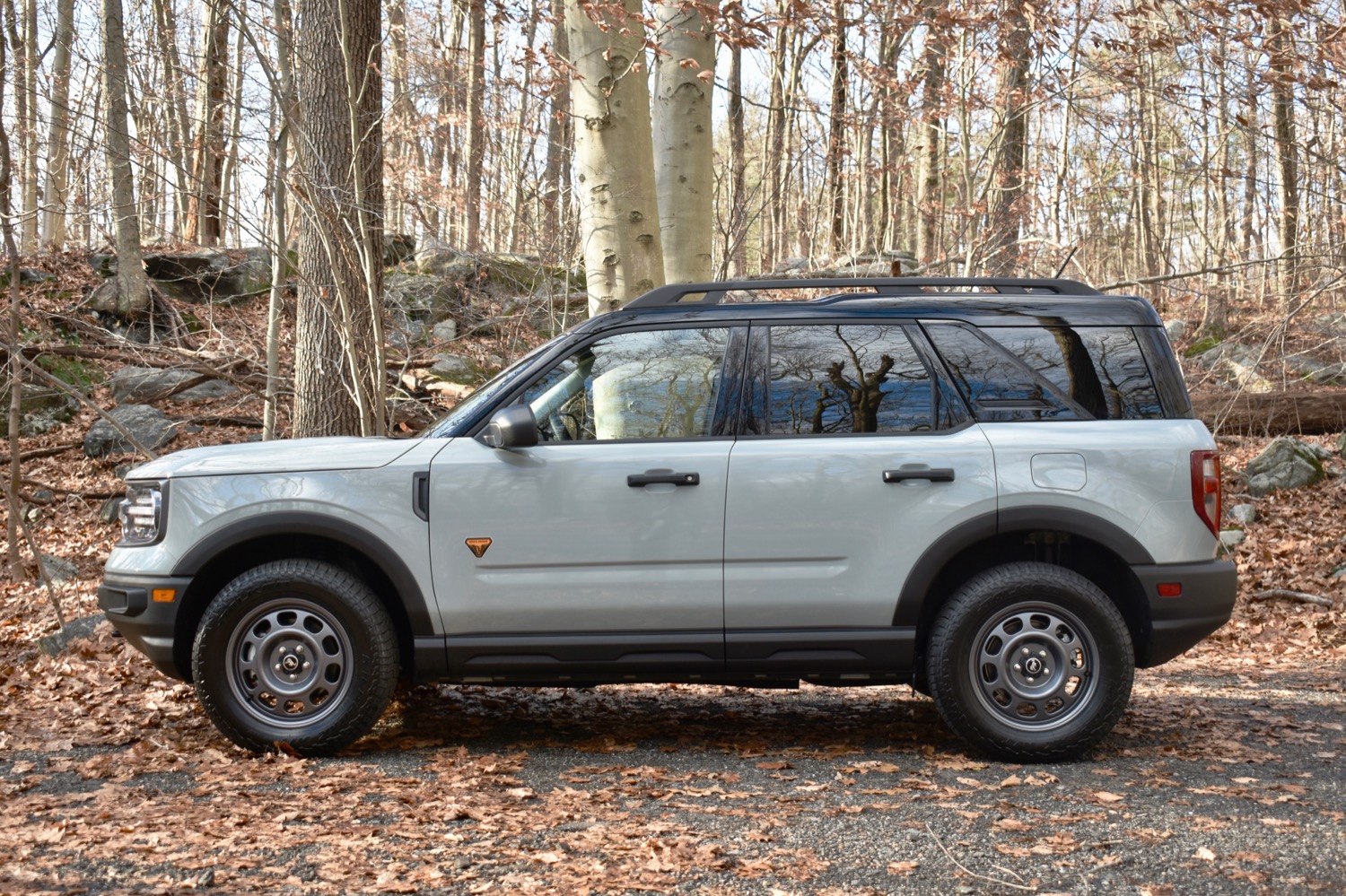
Ford is bringing back the Bronco—and it’s being very thorough about it.
As the original Bronco grew larger, Ford saw an opportunity to slot a smaller version beneath it in the lineup. So in 1984, Ford launched the Bronco II. That model was never as well-liked as the big Bronco, but it’s still getting a successor.
Like the Bronco II, the 2021 Ford Bronco Sport provides off-road capability in a tidier package than the standard Bronco. However, instead of using old-school body-on-frame construction, the Bronco Sport is a modern crossover — the default choice for many new-car buyers. There are at least a dozen similarly sized crossover SUVs, but with its focus on off-roading, the Bronco Sport specifically targets the Jeep Compass and Jeep Renegade.
Ford offers the Bronco Sport in base, Big Bend, Outer Banks, and Badlands trim levels, plus a First Edition model that has already sold out. Pricing starts at $28,155 (including destination) for the base trim level, while the Badlands we tested had a starting price of $32,660. The Ford Co-Pilot360 Assist+ bundle of driver aids, 17-inch wheels, and the destination charge brought the as-tested price to $35,745.
Design and interior
Ford’s designers tried hard to make the Bronco Sport look like its big sibling, which itself borrows heavily from the first-generation 1965 Bronco. The Sport has a square, upright profile, and the same grille and headlights as the 2021 Bronco, but without that SUV’s removable roof and doors. Our test car’s optional 17-inch aluminum wheels were even made to look like steel wheels for an additional retro touch. The styling really stood out, even among other SUVs.
Under the skin, however, the Bronco Sport has more in common with the Ford Escape than it does with the 2021 Bronco. It rides on a modified version of the Escape’s unibody platform, meaning the body and chassis are one piece. While the Bronco and some other off-road vehicles like the Jeep Wrangler use body-on-frame construction, with a separate chassis, unibodies are the preferred choice for most cars because of their greater structural rigidity and lower weight.
The interior doesn’t have quite as many retro touches as the exterior, but is still both distinctive and functional. Instead of trying to make the interior look fancy, Ford made it look rugged. Every surface is textured or rubberized, including the three large smartphone trays, and the floors on Badlands and First Edition models are washable, according to Ford. Chunky knobs are used for everything from tuning the radio to shifting the transmission, and they all have a satisfying feel.
The styling really stood out, even among other SUVs.
Our test car didn’t have the optional leather upholstery, but the standard materials seemed much for appropriate for a vehicle designed for outdoor adventure. The seats themselves weren’t very comfortable however. The narrow, flat bottom cushions and short backrests wouldn’t be ideal for daily commuting, let alone long road trips to some far-off campsite.
The Bronco Sport is fairly small, but passenger and cargo space are still competitive with rivals. The Ford has more headroom and front legroom than the Jeep Compass or Renegade, although the Compass has more rear legroom. At 29.4 cubic inches with the rear seats in place, and 60.6 cubic inches with the rear seats folded, the Bronco Sport also beats the Jeeps on cargo space. Other nice touches include power outlets and a built-in bottle opener in the cargo area, and labeled buttons to open the liftgate glass and the liftgate itself, so you don’t have to blindly grope for them.
Tech, infotainment, and driver assist
The Bronco Sport comes standard with Ford’s Sync 3 infotainment system on an 8.0-inch touchscreen, along with both Apple CarPlay and Android Auto compatibility. A 4.2-inch instrument cluster screen is standard, but our Badlands test car had the optional 6.5-inch display. Amazon Alexa compatibility is also available, and you can upgrade from the standard six-speaker audio system to a 10-speaker Bang & Olufsen system.
This is Ford’s last-generation infotainment system — the new Sync 4 system is already being rolled out on some models — but it still worked well. The touchscreen’s menus were easy to navigate, and Ford gave the system a neat-looking startup sequence with nature scenes and the Bronco logo. It’s too bad the rest of the graphics look plain in comparison, although the large text is easy to read while driving.
As mentioned above, the Bronco Sport has three large trays for smartphones, two placed ahead of the center console and one on a shelf below the touchscreen. You can plug in from any of these spots, and there’s an additional USB port in the center-console storage cubby. Second-row passengers don’t get any USB ports, though.
Sync 3 is Ford’s last-get infotainment system, but it still worked well.
The Bronco Sport comes standard with a decent amount of driver-assist tech under the Co-Pilot360 banner, including forward collision warning, automatic emergency braking with pedestrian detection, blind-spot monitoring, lane-keep assist, and automatic high beams. That’s more standard features than you get from Jeep, but the less-adventuresome Honda HR-V also offers adaptive cruise control as standard equipment.
To get that on the Bronco Sport, you’ll have to upgrade to Co-Pilot360 Assist+, which also adds automated lane centering, traffic sign recognition, and evasive steering assist for more power assist during emergency maneuvers. Our test car had this package and while we’ve had positive experiences with Ford’s lane-centering feature in the past, this time around it had the troublesome tendency to hug one side of the lane. The adaptive cruise control was also slow to respond to changes in set speed. After bumping up the speed by 5 mph using the steering wheel toggle, it took a few seconds for the car to accelerate.
Driving experience
Unlike most other crossovers, the Bronco Sport gets standard all-wheel drive. It also gets two engine options (depending on trim level), which carry over from the Escape. The base, Big Bend, and Outer Banks trim levels have a 1.5-liter turbocharged three-cylinder engine, which makes 181 horsepower and 191 pound-feet of torque. Badlands and First Edition models have a 2.0-liter turbo-four engine, with 245 hp and 275 lb-ft. An eight-speed automatic transmission is standard with both engines.
The base three-cylinder engine offers about the same amount of horsepower as the four-cylinder you get as standard equipment in the Jeep Renegade and Compass — with substantially more torque. Most similar-sized crossovers don’t even offer a bigger optional engine, let alone one that can match the output of the Bronco Sport’s 2.0-liter unit.
What sets the Bronco Sport apart from most other crossovers of its size (the Jeep duo being a notable exception) is its focus on off-road capability. The Badlands model gets standard 28.5-inch all-terrain tires, and every model gets what Ford calls “G.O.A.T. modes” — driving modes that change vehicle settings for different types of terrain. G.O.A.T. stands for “goes over any terrain,” which was Ford executive Donald Frey’s nickname for the original Bronco.
The 2.0-liter engine was very responsive, with plenty of power to scoot away from traffic lights or exploit gaps in traffic.
This tech, which takes much of the guesswork out of off-roading, is also available from Jeep in the form of the Selec-Terrain system. Crucially, both Ford and Jeep also offer drivetrains with low-speed “crawl” ratios, which allow vehicles to creep along at low speeds with minimal throttle input. You don’t want a heavy foot when driving over slippery surfaces like mud or loose rocks. The Bronco Sport has an 18:1 crawl ratio, while the Compass and Renegade have ratios of 20:1 and 21.5:1, respectively (higher numbers are better). However, the Bronco Sport has more ground clearance than the Jeeps (8.8 inches) and can wade into deeper water (23.6 inches), according to Ford.
We didn’t have time to test out these capabilities during our brief stint with the Bronco Sport, but we did find that this off-roader is remarkably nice to drive on-road. The 2.0-liter engine was very responsive, with plenty of power to scoot away from traffic lights or exploit gaps in traffic. While it’s no Mustang, the Bronco Sport also turns into corners with a predictability and eagerness its more carlike Ford Escape sibling lacks.
The interior was nice and quiet, except for tire roar, a typical compromise of all-terrain rubber. The Bronco Sport also combines a tall driving position with an upright roof and tall side windows, providing excellent outward visibility and an old-school SUV feel. Many modern vehicles have that tall driving position, but a fairly low, swoopy roof, which can create a claustrophobic feeling and make seeing out difficult.
Gas mileage and safety
The Bronco Sport may look like an old-school truck, but its gas mileage is more like a modern car’s. Models with the base 1.5-liter engine get an Envornmental Protection Agency-rated 26 mpg combined (25 mpg city, 28 mpg highway), while the larger 2.0-liter engine gets 23 mpg combined (21 mpg city, 26 mpg highway). We arrived at 25.9 mpg in our 2.0-liter test car, according to the car’s trip computer.
Safety ratings from the Insurance Institute for Highway Safety (IIHS) and National Highway Traffic Safety Administration (NHTSA) aren’t available yet. That’s often the case with new vehicles like the Bronco Sport.
Ford’s three-year, 36,000-mile bumper-to-bumper warranty and five-year, 60,000-mile powertrain warranty are comparable to most other mainstream brands. Ford doesn’t have the best reputation for reliability, but then again, neither do the Jeep SUVs the Bronco Sport targets.
How DT would configure this car
The distinguishing feature of the Bronco Sport is its off-road capability, so it makes sense to emphasize that. This makes the Badlands trim level the best choice, as it includes off-road suspension, an upgraded all-wheel drive system, and all-terrain tires. It also comes standard with the larger, more powerful 2.0-liter engine.
Ford offers options to gussy up the Badlands with things like leather upholstery, but we’d skip that and save some money. Like most mainstream cars, the Bronco Sport is more appealing in its basic form than when trying to be fancy. If you want luxury, buy a Lincoln.
The Badlands doesn’t get the full complement of driver-assist tech as standard equipment, though, so we’d add the Ford Co-Pilot360 Assist+ package ($795), which includes adaptive cruise control, automated lane centering, traffic sign recognition, and evasive steering assist.
Those are the essentials in terms of tech and capability. Depending on how you plan to use your Bronco Sport, it might also be worth checking out the list of Yakima accessories Ford plans to offer through dealerships, including a rooftop tent and various racks to hold bikes, canoes, or snowboards.
Our take
The proliferation of SUVs has also watered them down. From the Honda HR-V to the Kia Seltos, there are plenty of other similar-sized vehicles in the Bronco Sport’s price range, but most of them feel a lot like ordinary cars.
The Bronco Sport’s styling and off-road capability make it a true SUV in a crowd of glorified hatchbacks. While the Jeep Compass and Renegade are also designed for off-roading, the Ford offers more cargo space, a more comprehensive array of driver-assist tech, and a more powerful (albeit optional) engine.
The Bronco Sport may be the baby sibling of the 2021 Ford Bronco, but among similar vehicles, it’s king of the hill.
Should you get one?
Yes. The Bronco Sport takes the SUV genre back to its roots.







